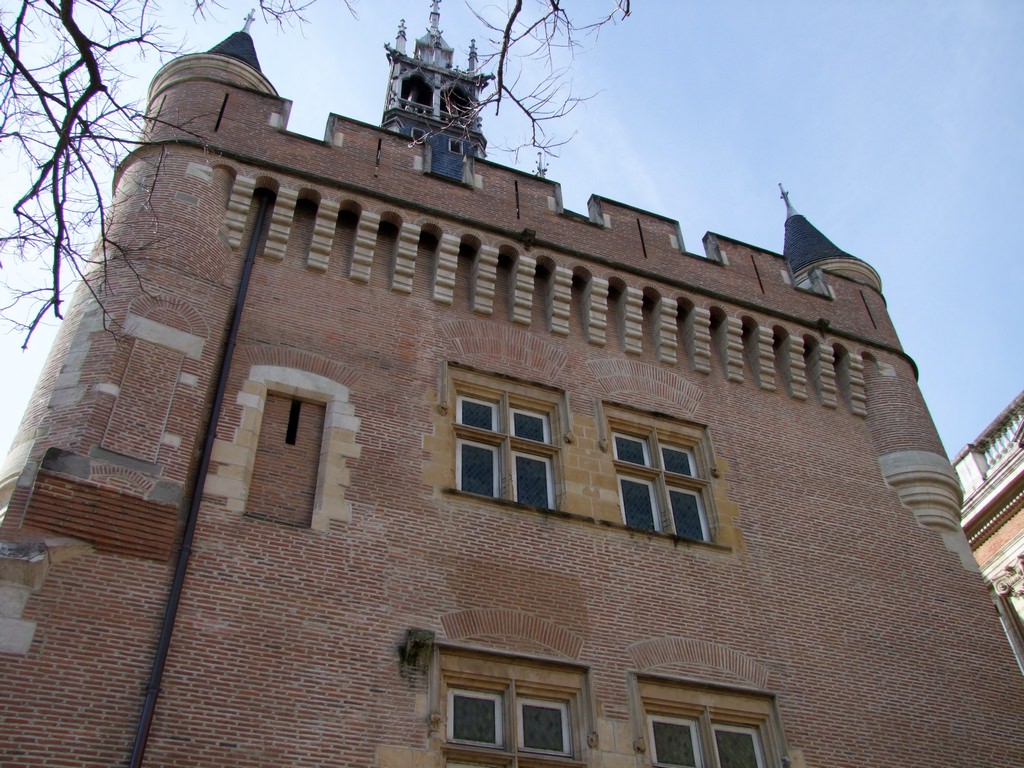
Toulouse and the Canal du Midi:
explorations and historic sites
The city of Toulouse is intimately connected to the history of the Canal du Midi and is a great place to see some of the canal's iconic sights. Whether you choose to explore Toulouse by boat, by bike or on foot, you'll enjoy exploring along the water's edge. As well as the canal, the city of Toulouse is also well worth the detour thanks to its history and architecture. This is a fantastic stopover town that you won't want to miss!
The history of the Canal du Midi in Toulouse
Toulouse, where the Canal du Midi begins
The Canal du Midi starts in Toulouse and ends in Marseillan 240 km away, where it flows into the Thau lagoon.
It was also in Toulouse that Pierre-Paul Riquet, the canal's designer, began building his canal. The first lock was built there in 1667 by Riquet. This was the lock that led down to the Garonne, but it is no longer there today.
The Port de l’Embouchure with its famous twin bridges is where the Canal du Midi begins. Today, this is the mouth and the point at which three canals merge: the Canal de Garonne, the Canal du Midi and the Canal de Brienne. The Canal de Brienne was built between 1768 and 1775, a century after the Canal du Midi, to link the Garonne river to the Canal du Midi. In 1856, the Canal de Garonne was opened, making it easier to sail to Bordeaux than along the Garonne river, which had been the only solution up until then.
Toulouse is a city that was shaped by the Canal du Midi
As soon as the canal was put into operation, it was necessary to build a number of facilities for administrative purposes and to manage river navigation. These facilities shaped the city of Toulouse.
All the political, administrative and commercial buildings for this unique waterway network were concentrated in the area of Port Saint-Etienne, built in the 18th century:
- chamber of justice for the canal domain at the Château du Canal,
- the Canal du Midi archives building,
- canal administration offices and storage warehouses,
- the Halle aux Grains, etc.
The head office of the regional branch of Voies Navigables de France, in charge of managing the Canal du Midi, is still here today.
The Port Saint-Sauveur, was built later in 1830 to support the Port Saint-Etienne which had become too small. During the same period, the Cales de Radoub were created nearby, close to the Pont des Demoiselles bridge, and this was where boats could be built and repaired.
Later, the Canal de Brienne and the Canal de Garonne were built, and also contributed to shaping the city of Toulouse.
The Bassin des Filtres in Les Amidonniers, an atypical place in Toulouse that was built in 1842, allowed water from the Garonne river to be filtered and then used to supply the Canal de Garonne.
Today, we can still see traces and ruins of the former activities once linked to the Canal du Midi. These features are now part and parcel of the urban landscape!
Did you know?
The locks in Toulouse are not the typical oval shape of the other Canal du Midi locks. The first ones in Toulouse were in fact built with a straight lock wall. Very quickly, Riquet noticed that the locks were becoming distorted due to the pressure of the soil when the basin was empty.
He then changed the plans so that all future locks were an oval shape, to provide better resistance against the pressure of the soil.
Toulouse and the Riquet family
Pierre-Paul Riquet knew they city of Toulouse very well. A long time before building his canal, he stayed for six or seven years in an auberge near the convent of the Augustins, and then in a house he purchased at n°1 Place Roger Salengro. After that he acquired the Domaine de Bonrepos nearby where he studied the water supply system for the Canal du Midi.
In 1675, he purchased the Hôtel Frascati which now corresponds to the biggest part of the Jardin des Plantes. This is where Riquet spent his last days. After his death on 2 October 1680, Riquet was buried at Saint-Etienne Cathedral in Toulouse. The Canal du Midi was only completed six months later!
Did you know?
In memory of Riquet in 1827, the city council commissioned sculpter Bernard Griffoul-Dorval to create a statue in honour of the canal's creator. The statue was completed in 1838 but only installed near the canal in 1853.
A question was raised: should Riquet be pointing to the canal and have his back to the walkways? Or on the contrary, should he be facing the bottom end of the walkways and have his back to the canal?
The 2nd solution was chosen and so Riquet has his back to the canal!

Statue de Pierre-Paul Riquet, Toulouse
The must-sees of the Canal du Midi
in Toulouse
Due to its history and noble past, the city of Toulouse is one of the oldest capitals of the Estates of Languedoc. As the crossroads between the Mediterranean and the Garonne, it was only natural that Riquet chose this city as the departure point for his canal. That is why the city of Toulouse is now brimming with historic and iconic sites of the Canal du Midi.
Here are some unmissable sights while you're staying in the Pink City.
A future makeover for the Canal du Midi in Toulouse
VNF (Voies Navigables de France) is currently working on a partnership with Toulouse Métropole, to revamp the Canal du Midi urban and heritage sites in Toulouse.
Together with the current canal management team, three sites were selected:
- Port Saint-Etienne with the château and archives building
- The Bassin des Filtres in Les Amidonniers
- The Cales de Radoub at the Pont des Demoiselles bridge.
The purpose of this project is to showcase the memory and identity of the three sites, to reposition the work of the VNF within these three sites, and to make them more attractive for the locals of Toulouse. At the same time, Toulouse Métropole is working on another project in partnership with VNF, entitled 'grand parc canal', the aim of which is to showcase the network of canals that cross through the city.
Exploring the banks of the Canal du Midi
in Toulouse
On foot or by bike
There are some great, peaceful places to go in Toulouse for a walk or bike ride alongside the canal, a perfect way to escape the city for a few hours.
You choose how you want to explore the lush-green banks of the Canal du Midi, on foot or by bike.
Find out everything you need to know about the Canal du Midi greenway route
By boat
You don't need to leave Toulouse to board a boat and explore the Canal du Midi from the water. For a few hours or a few days, you can expect an unforgettable experience on a boat trip along the Canal du Midi.
There are also water-based activities available to explore the Canal du Midi in a different way.
Practical information
To make the most of your stay in Toulouse and the activities on offer in the city, here is some practical information you might find useful
Contact Toulouse Tourist Office
Contact
and information
TOURIST OFFICE OF TOULOUSE / ATTRACTIVITY AGENCY OF TOULOUSE METROPOLE Square Général de Gaulle
BP 38001
31080 TOULOUSE
Tél : 05 17 42 31 31

Some pictures of the Canal du Midi
-
Pont et écluse des Minimes, Toulouse, 1905 - Collection Sicard
-
Stèle du baron Pierre-Paul Riquet - cathédrale Saint-Etienne à Toulouse
-
Lavoir, Toulouse, 1910 - Collection Sicard
-
Statue de Pierre-Paul Riquet, Toulouse
-
Statue de Riquet, Toulouse, 1949 - Collection Sicard
-
Canal du Midi à Toulouse - VNF

























